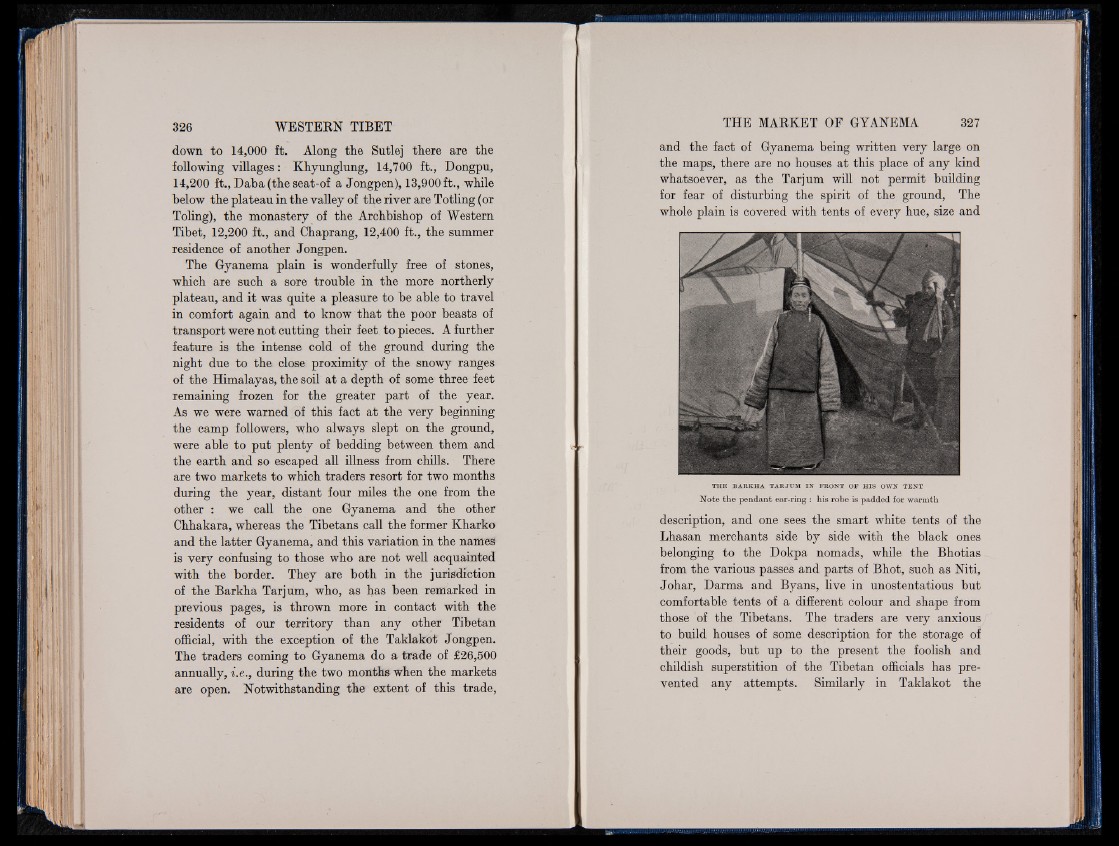
down to 14,000 ft. Along the Sutlej there are the
following villages: Khyunglung, 14,700 ft., Dongpu,
14,200 ft., Daba (the seat-of a Jongpen), 13,900 ft., while
below the plateau in the valley of the river are Totling (or
Toling), the monastery of the Archbishop of Western
Tibet, 12,200 ft., and Chaprang, 12,400 ft., the summer
residence of another Jongpen.
The Gyanema plain is wonderfully free of stones,
which are such a sore trouble in the more northerly
plateau, and it was quite a pleasure to be able to travel
in comfort again and to know that the poor beasts of
transport were not cutting their feet to pieces. A further
feature is the intense cold of the ground during the
night due to the close proximity of the snowy ranges
of the Himalayas, the soil at a depth of some three feet
remaining frozen for the greater part of the year.
As we were warned of this fact at the very beginning
the camp followers, who always slept on the ground,
were able to put plenty of bedding between them and
the earth and so escaped all illness from chills. There
are two markets to which traders resort for two months
during the year, distant four miles the one from the
other : we call the one Gyanema and the other
Chhakara, whereas the Tibetans call the former Kharko
and the latter Gyanema, and this variation in the names
is very confusing to those who are not well acquainted
with the border. They are both in the jurisdiction
of the Barkha Tarjum, who, as has been remarked in
previous pages, is thrown more in contact with the
residents of our territory than any other Tibetan
official, with the exception of the Taklakot Jongpen.
The traders coming to Gyanema do a trade of £26,500
annually, i.e., during the two months when the markets
are open. Notwithstanding the extent of this trade,
and the fact of Gyanema being written very large on
the maps, there are no houses at this place of any kind
whatsoever, as the Tarjum will not permit building
for fear of disturbing the spirit of the ground, The
whole plain is covered with tents of every hue, size and
THE BARKHA TARJUM IN FRONT OF HIS OWN TENT
Note the pendant ear-ring : his robe is padded for warmth
description, and one sees the smart white tents of the
Lhasan merchants side by side with the black ones
belonging to the Dokpa nomads, while the Bhotias
from the various passes and parts of Bhot, such as Niti,
Johar, Darma and Byans, live in unostentatious but
comfortable tents of a different colour and shape from
those of the Tibetans. The traders are very anxious
to build houses of some description for the storage of
their goods, but up to the present the foolish and
childish superstition of the Tibetan officials has prevented
any attempts. Similarly in Taklakot the